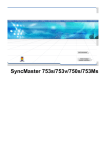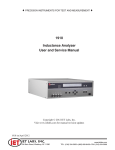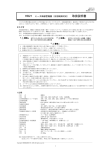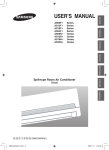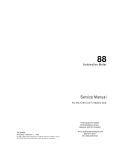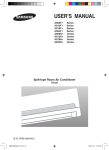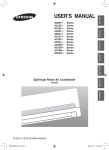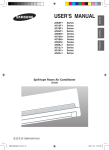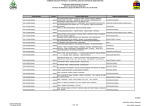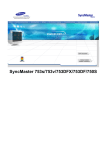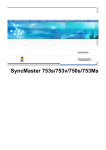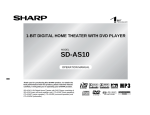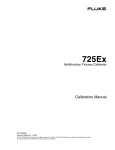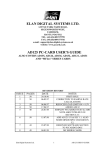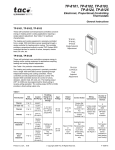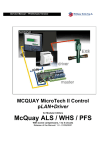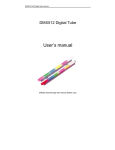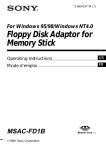Download 12B 18 7 Series
Transcript
® 12B 18 7 Series Meters Service Manual PN 602730 August 1996 © 1996 Fluke Corporation, All rights reserved. Printed in U.S.A. All product names are trademarks of their respective companies. LIMITED WARRANTY & LIMITATION OF LIABILITY Each Fluke product is warranted to be free from defects in material and workmanship under normal use and service. The warranty period for Models 7-300, 7-600, and 12B is two years and begins on the date of shipment. The warranty period for Model 18 is three years and begins on the date of shipment. Parts, product repairs and services are warranted for 90 days. This warranty extends only to the original buyer or end-user customer of a Fluke authorized reseller, and does not apply to fuses, disposable batteries or to any product which, in Fluke’s opinion, has been misused, altered, neglected or damaged by accident or abnormal conditions of operation or handling. Fluke warrants that software will operate substantially in accordance with its functional specifications for 90 days and that it has been properly recorded on non-defective media. Fluke does not warrant that software will be error free or operate without interruption. Fluke authorized resellers shall extend this warranty on new and unused products to end-user customers only but have no authority to extend a greater or different warranty on behalf of Fluke. Warranty support is available if product is purchased through a Fluke authorized sales outlet or Buyer has paid the applicable international price. Fluke reserves the right to invoice Buyer for importation costs of repair/replacement parts when product purchased in one country is submitted for repair in another country. Fluke’s warranty obligation is limited, at Fluke’s option, to refund of the purchase price, free of charge repair, or replacement of a defective product which is returned to a Fluke authorized service center within the warranty period. To obtain warranty service, contact your nearest Fluke authorized service center or send the product, with a description of the difficulty, postage and insurance prepaid (FOB Destination), to the nearest Fluke authorized service center. Fluke assumes no risk for damage in transit. Following warranty repair, the product will be returned to Buyer, transportation prepaid (FOB Destination). If Fluke determines that the failure was caused by misuse, alteration, accident or abnormal condition of operation or handling, Fluke will provide an estimate of repair costs and obtain authorization before commencing the work. Following repair, the product will be returned to the Buyer transportation prepaid and the Buyer will be billed for the repair and return transportation charges (FOB Shipping Point). THIS WARRANTY IS BUYER’S SOLE AND EXCLUSIVE REMEDY AND IS IN LIEU OF ALL OTHER WARRANTIES, EXPRESS OR IMPLIED, INCLUDING BUT NOT LIMITED TO ANY IMPLIED WARRANTY OF MERCHANTABILITY OR FITNESS FOR A PARTICULAR PURPOSE. FLUKE SHALL NOT BE LIABLE FOR ANY SPECIAL, INDIRECT, INCIDENTAL OR CONSEQUENTIAL DAMAGES OR LOSSES, INCLUDING LOSS OF DATA, WHETHER ARISING FROM BREACH OF WARRANTY OR BASED ON CONTRACT, TORT, RELIANCE OR ANY OTHER THEORY. Since some countries or states do not allow limitation of the term of an implied warranty, or exclusion or limitation of incidental or consequential damages, the limitations and exclusions of this warranty may not apply to every buyer. If any provision of this Warranty is held invalid or unenforceable by a court of competent jurisdiction, such holding will not affect the validity or enforceability of any other provision. Fluke Corporation P.O. Box 9090 Everett, WA 98206-9090 U.S.A. 5/94 Fluke Europe B.V. P.O. Box 1186 5602 BD Eindhoven The Netherlands Table of Contents Chapter 1 Title Page Introduction and Specifications........................................................ 1-1 Introduction ....................................................................................................... 1-1 Specifications .................................................................................................... 1-1 2 Theory of Operation........................................................................... 2-1 Introduction ....................................................................................................... Analog Measurement IC (U1) ........................................................................... Microcomputer IC (U2)..................................................................................... Automatic Selection Input Resistance............................................................... 3 Maintenance ....................................................................................... 3-1 Introduction ....................................................................................................... Disassembly and Reassembly............................................................................ Cleaning............................................................................................................. Performance Tests ............................................................................................. Calibration Adjustments for Models 12B and 18.............................................. Calibration Adjustments for Models 7-300 and 7-600...................................... 4 2-1 2-1 2-3 2-3 3-1 3-1 3-6 3-6 3-9 3-10 Parts and Schematics........................................................................ 4-1 Introduction ....................................................................................................... How to Obtain Parts .......................................................................................... Manual Status Information................................................................................ Newer Instruments............................................................................................. Parts Lists, Drawings, and Schematics.............................................................. i 4-1 4-1 4-2 4-2 4-2 12/18/7 Service Service Manual ii List of Tables Table 1-1. 2-1. 2-2. 3-1. 3-2. 3-3. 4-1. 4-2. 4-3. 4-4. Title Page Specifications......................................................................................................... Electrical Components on Main PCA.................................................................... U1 Pinout Table..................................................................................................... Required Equipment .............................................................................................. Performance Tests for Models 7-300 and 7-600 ................................................... Performance Tests for Models 12B and 18 ........................................................... Manual Status Information .................................................................................... Models 12B, 18, and 18/AL Final Assembly ........................................................ Models 7-300 and 7-600 Final Assembly.............................................................. A1 Main PCA ........................................................................................................ iii 1-2 2-2 2-4 3-6 3-7 3-8 4-2 4-3 4-5 4-7 12/18/7 Service Service Manual iv List of Figures Figure 2-1. 3-1. 3-2. 3-3. 3-4. 4-1. 4-2. 4-3. 4-4. 4-5. 4-6. 4-7. Title Page Typical Automatic Selection Input Resistance with DC Volts Function Selected Models 12B and 18 Disassembled Unit................................................................. Models 7-300 and 7-600 Disassembled Unit......................................................... Removing and Reinserting the Printed Circuit Assembly .................................... Calibration Adjustment.......................................................................................... Models 12B and 18 Final Assembly...................................................................... Models 7-300 and 7-600 Final Assembly.............................................................. Models 12B, 18, 7-300, and 7-600 Main PCA Components ................................. Model 12B Schematic............................................................................................ Model 18 Schematic .............................................................................................. Model 7-300 Schematic ......................................................................................... Model 7-600 Schematic ......................................................................................... v 2-3 3-3 3-4 3-5 3-10 4-4 4-6 4-9 4-10 4-12 4-14 4-16 12/18/7 Service Service Manual vi MULTIMETER SAFETY The Fluke 7-300, 7-600, 12B, and 18 Meters have been designed and tested according to IEC Publication 1010, Safety Requirements for Electronic Measuring Apparatus. This manual contains information and warnings that must be followed to ensure safe operation and keep the meter in safe condition. Use of this equipment in a manner not specified herein may impair the protection provided by the equipment. These multimeters comply with part 15 of the FCC Rules. Operation is subject to the following two conditions: (1) these meters may not cause harmful interference, and (2) these meters must accept any interference received, including interference that may cause undesired operation. Some common international electrical symbols are shown below: X AC: ALTERNATING CURRENT DANGEROUS VOLTAGE DC: DIRECT CURRENT EARTH GROUND EITHER AC OR DC CURRENT SEE EXPLANATION IN MANUAL FUSE DOUBLE INSULATION FOR PROTECTION AGAINST ELECTRIC SHOCK Before using the meter, read the following safety information carefully. In this manual, "Warning" is reserved for conditions and actions that pose hazard(s) to the user; "Caution" is reserved for conditions and actions that may damage your meter. • Avoid working alone. • Follow all safety procedures for equipment being tested. • Inspect the test leads for damaged insulation or exposed metal. Check test lead continuity. Damaged leads should be replaced. • Be sure the meter is in good operating condition. • Select the proper function for your measurement. • To avoid electrical shock, use caution when working above 60V dc or 30V ac rms. • Disconnect the live test lead before disconnecting the common test lead. • Disconnect the power and discharge high-voltage capacitors before testing in resistance and diodes or continuity. • When making a current measurement, turn the circuit power off before connecting the meter in the circuit. • Check meter fuses before measuring transformer secondary or motor winding current. An open fuse may allow high voltage build-up, which is potentially hazardous. • Use clamp-on probes when measuring circuits exceeding 10 amps. • When servicing the meter, use only the replacement parts specified. • Do not allow the meter to be used if it is damaged or if its safety features are impaired. Chapter 1 Introduction and Specifications Introduction PWarning Service procedures described herein should be performed by qualified personnel only. To avoid electric shock, perform only those service procedures described in this manual. The 12B, 18, 7 Series Service Manual provides the information necessary to service the Fluke Model 12B, Model 18, and Models 7-300 and 7-600 meters. This manual provides the following information: • Specifications (Chapter 1) • Basic theory of operation (Chapter 2) • Disassembly and reassembly (Chapter 3) • Performance tests (Chapter 3) • Calibration (Chapter 3) • Illustrated parts lists and schematic diagrams (Chapter 4) Refer to the users instruction sheet for operating instructions. Specifications Specifications are in Table 1-1. Accuracy is specified for a period of one year after calibration, at 18ºC to 28ºC (64ºF to 82ºF) with relative humidity to 90%. AC conversions are ac-coupled, average responding, and calibrated to the rms value of a sine wave input. 1-1 12B/18/7 Series Service Manual Accuracy specifications are given as follows: ±([% of reading] + [number of least significant digits]) Table 1-1. Specifications Maximum Voltage Between any Terminal and Earth Ground (excludes 10% tolerance) 600V ac rms or dc Display 3-3/4-digits, 4000 counts, updates 4/sec Operating Temperature -10°C to 50°C Storage Temperature -30°C to 60°C indefinitely (to -40°C for 100 hrs) Temperature Coefficient 0.1 x (specified accuracy)/°C (<18°C or >28°C) Relative Humidity 0% to 90% (-10°C to 35°C) 0% to 70% (35°C to 50°C) Battery Type 9V, NEDA 1604 or IEC 6F22 Battery Life 650 continuous hours with alkaline; 600 hours for Model 7 450 continuous hours with carbon-zinc; 400 hours for Model 7 Shock, Vibration 1 meter shock. Per MIL-T-28800D for a Class 3 Instrument Size (HxWxL) 1.35 in x 2.75 in x 5.55 in (3.46 cm x 7.05 cm x 14.23 cm) Weight 10 oz (286g) EMI Regulations Complies with FCC Part 15, Class B, and VDE 0871B. Safety Designed to Protection Class II requirement of UL1244, ANSI/ISA-S82.01 - 1988, CSA C22.2 No 231, and VDE 0411, and IEC 1010-1 overvoltage category III (CAT III), 600V. Trademark of TÜV Product Services. IEC 348 certification; designed to comply with EN 61010-1: 1993. 1-2 Introduction and Specifications Specifications 1 Table 1-1. Specifications (continued) Accuracy (50 to 400 Hz) Function f Range 1 4000 mV J K LM3 1 mV 7-300 NA 2 7-600 NA 2 12B/18 ±(1.9%+3) 4.000V 0.001V NS NS ±(1.9%+3) 40.00V 0.01V ±(2.9%+3) ±(2.9%+3) ±(1.9%+3) 300.0V 0.1V ±(2.9%+3) NA NA 400.0V 0.1V NA ±(2.9%+3) ±(1.9%+3) 1V NA ±(2.9%+3) ±(1.9%+3) 1 mV NA NA ±(0.9%+2) 600.0V E Resolution 1 4000 mV 2 2 4.000V 0.001V NS NS ±(0.9%+2) 40.00V 0.01V ±(1.5%+1) ±(1.5%+1) ±(0.9%+1) 300.0V 0.1V ±(1.5%+1) NA NA 400.0V 0.1V NA ±(1.5%+1) ±(0.9%+1) 600V 1V NA ±(1.5%+1) ±(0.9%+1) 400.0Ω 0.1Ω ±(1.5%+2) ±(1.5%+2) ±(0.9%+2) 4.000 kΩ 0.001 kΩ NA NA ±(0.9%+1) 40.00 kΩ 0.01 kΩ NA NA ±(0.9%+1) 400.0 kΩ 0.1 kΩ NA NA ±(0.9%+1) 4.000 MΩ 0.001 MΩ NA NA ±(0.9%+1) 40.00 MΩ 0.01 MΩ NA NA ±(1.5%+3) 1.000 µF 0.001 µF NA NA ±(1.9%+2) 10.00 µF 0.01 µF NA NA ±(1.9%+2) 100.0 µF 0.1 µF NA NA ±(1.9%+2) 1000 µF 1 µF NA NA ±(1.9%+2) 10000 µF 10 µF NA NA ±(10%+90) typical 2.000V 0.001V NA NA ±(0.9%+2) 1. The 4000 mV range can be entered only in the manual range mode. Use the 4000 mV range with accessories. The 4000 mV range is not available on the Model 7. 2. Not specified for the Model 7. 3. The beeper is guaranteed to come on at <25Ω and turn off at >250Ω. The meter detects opens or shorts of 250 µs or longer. These values are not specified for the Model 7. 1-3 12B/18/7 Series Service Manual Table 1-1. Specifications (continued) Overload 1 Protection Input Impedance (Nominal) f 600V rms or dc >5 MΩ <100pF Automatic Selection and LoZ = >2 kΩ <200pF 3 (ac coupled) E 600V rms or dc >10MΩ <100pF Function 2 2 Automatic Selection and LoZ = >2 kΩ 3 <200pF Open Circuit Test Voltage J 600V rms or dc <1.5V dc L2 600V rms or dc 2.4-3.0V dc Common Mode Rejection Ratio (1 kΩ 2 Unbalanced) Normal Mode 2 Rejection >60 dB at dc 50 or 60 Hz >100 dB at dc, 50 or 60 Hz >50 dB at 50 Hz or 60 Hz Full Scale Voltage To 4.0 MΩ 40 MΩ <450 mV dc Short Circuit Current <500 µA <1.5V dc 2.400V dc 0.95 mA (typical) 1. 3 x 106 V Hz maximum. 2. Does not apply to Model 7. 3. ~2 kΩ input impedance up to 50V. Impedance increases with input voltage to >300 kΩ at 600V. MIN MAX Recording Accuracy and Response Time (Models 12B and 18) Specified accuracy of the measurement function ±12 digits for changes >200 ms in duration (±40 digits in ac). Typical 100 ms response to 80%. MIN MAX Recording with Elapsed Time (Models 12B and 18) Elapsed Time: 0 to 100 hours (99.59) Resolution: 1 minute Accuracy: 0.3% typical Continuity Capture (Model 12B) (Open/Short Capture Model 18) Detects opens or shorts of 250 µs or longer. 1-4 Chapter 2 Theory of Operation Introduction Chapter 2 provides a basic theory of operation for the Models 7, 12B, and 18 Meters. Electrical components on the printed circuit assembly (A1 Main PCA) are listed in Table 2-1. Refer to Figure 4-3 for the location of these components and Figures 4-4 through 4-7 for the schematic diagrams. The analog/digital IC (U1) performs the electrical measurement functions. See Table 2-2 for pin names and descriptions. The microcomputer (U2) controls U1, the LCD (U3), and the user interface. Discrete components support U1 and U2, provide reference standards for measurements, and provide input overload protection. Analog Measurement IC (U1) U1 performs the following analog functions: a/d converter, ac to dc converter, Automatic Selection circuitry, active filter, passive filter, power supply, range configuration circuitry, signal routing circuitry, beeper driver, digital control circuitry, and digital U2 interface circuitry. The a/d converter is a patented dual-rate, dual-slope converter. The dual-rate conversion allows for MIN MAX (Models 12B and 18 only) and fast autoranging functions. The ac to dc converter is full-wave rectified and average-responding. The active and passive filters are two-pole and one-pole low-pass filters (respectively) that are used for signal filtering prior to a/d conversion. The internal power supply generates a ground voltage nominally +3V relative to VSS. Range configuration circuitry connects the Z1 resistor network as needed for different ranges. Routing circuitry connects the various signal conditioning circuits as needed. The a/d converter and a counter are controlled by a state machine. 2-1 12B/18/7 Series Service Manual Table 2-1. Electrical Components on Main PCA Circuit and Function 2-2 Component Designator(s) Analog Measurement IC U1 Microcomputer IC U2 Input Divider and Ohms Reference Resistor Network Z1 Input Divider AC Coupling Capacitor C14 J2 Input Receptacle Voltage Sense Resistor R17 J1 Input Receptacle Voltage Sense Resistor R14 Reference Voltage for Volts Measurements VR1, R4, R5, R6, R26 A/D Converter Integrate Capacitor C2 A/D Converter Autozero Capacitor C1 A/D Converter Gain Resistors R1, R3, R15 Active Filter Components R7, R8, C5, C6 Passive Filter Components R9, C7 AC to DC Converter Gain Resistors R11, R12, R13 AC to DC Converter AC Coupling Capacitor C8 Bias Current Setting Resistor R2 DGND-VSS Voltage Setting Resistors R10, R24 Power Supply Bypass Capacitors C3, C15 Reverse Battery Protection CR1 System Clock Y1 Automatic Selection Input Current Limiters R16, R18, R29 Automatic Selection Input Positive Temp. Coef. Thermistor RT1 Automatic Selection Input Voltage Clamp Circuit Q1, Q2, CR2, R28 Automatic Selection Input Fusible Resistor R19 Microcomputer Reset Circuit R23, R25, C10, C13, CR3 On/Off and Automatic Selection Select Slide Switch S1 Beeper LS1 Beeper Current Limiter R22 Slide Switch Protection E1 Switch Sense Bypass Capacitor C9 Input Divider Bypass Capacitor C16 Zero Ohm Jumpers R20, R21, R27 Theory of Operation Microcomputer IC (U2) 2 Finally, digital circuitry interfaces with U2 via a parallel address and bidirectional data bus. Voltage is measured using a ratio comparison of the unknown voltage to the reference voltage (REFI pin). Resistance is calculated using a ratio comparison of the voltage across the unknown resistor to the voltage across a precision reference resistor, with the same current in both. Capacitance is measured by determining the amount of charge added for a given dc voltage change. Microcomputer IC (U2) U2 writes range settings and a/d converter information to U1. U2 reads a/d converter results and status information. This includes the low battery check, slide-switch position, continuity check, and Automatic Selection data. The microcomputer performs math operations on the raw data from U1 and configures it for the LCD. U2 also reads pushbutton inputs. Finally, the 2.1 MHz clock signal at U2 is divided down to 131 kHz and sent to U1 (CLK pin) for the counter. Automatic Selection Input Resistance As shown in Figure 2-1, the input resistance for the Automatic Selection function is nonlinear. The data in the graph are for the volts dc function (any range) and are the steady state values obtained after the PTC thermistor (RT1) has stabilized. The data also apply for the volts ac function. Small Signal Input Tesistance (kΩ) 500 Positive DCV Input 100 50 10 5 Negative DCV Input 1 0.1 0.5 1.0 5.0 10.0 |Vin| (Vdc) 50.0 500.0 as01f.eps Figure 2-1. Typical Automatic Selection Input Resistance with DC Volts Function Selected 2-3 12B/18/7 Series Service Manual Table 2-2. U1 Pinout Table Pin No. 2-4 Pin Name Description 1 READ (L) When low (VSS), data from addressed register can be read 2 ADR5 Most significant address bus line 3 ADR4 Bit 4 of parallel address bus 4 ADR3 Bit 3 of parallel address bus 5 ADR2 Bit 2 of parallel address bus 6 ADR1 Bit 1 of parallel address bus 7 ADR0 Least significant address bus line 8 VSS Negative power supply voltage (-3V relative to DGND) 9 VDD Positive power supply voltage for analog only (Vbat-3V=VDD-DGND) 10 K0 1st a/d gain resistor pin, generally for de-integrate 11 K1 2nd a/d gain resistor pin, generally for integrate 12 K2 3rd a/d gain resistor pin, for autozero 13 AZ A/D converter pin for autozero capacitor 14 INT A/D converter pin for integrator capacitor 15 REFI 1.00V reference voltage for de-integrate signal in volts 16 BIAS Pin for analog bias current generator reference resistor 17 REFH Connects 1.235V reference voltage to on-chip circuits 18 BGND Not used 19 AFO Active filter high output pin (2-pole, low-pass filter) 20 FAO Internal active filter node 21 FAI Internal active filter node 22 AFI Active filter high input pin 23 VSS Negative power supply voltage (-3V relative to DGND) 24 PFO Passive filter low output pin (1-pole, low-pass filter) 25 AVAOM Absolute value amp (full wave rectified) negative output pin 26 AVAOP Absolute value amp (full wave rectified) positive output pin 27 AVAM Absolute value amp inverting input (summing node) 28 ACBO AC buffer output 29 VSET Voltage divider sense for power supply 30 PSTEST Pin to disable on-chip power supply for U1 testing 31 DGND Ground power supply pin connected to common (digital ground) 32 AGND Common input sense line. No current flow (analog ground). 33 CLAMP Op amp output voltage for Q2 clamp transistor base drive 34 AMPS Shunt resistor sense pin. Unused in Fluke Model 18. 35 ISRC Current source pin for continuity, ohms, and capacitance 36 SWS Slide-switch position sense pin. Internal pull down. 37 OHMS Ohms sense resistor input pin. Sense voltage at J2. 38 VSS Negative power supply voltage (-3V relative to DGND) 39 ACV AC volts input pin from 10 MΩ resistor Theory of Operation Automatic Selection Input Resistance 2 Table 2-2 U1 Pinout Table (continued) Pin No. Pin Name Description 40 APV0 DC volts input pin from 10 MΩ resistor 41 DIVLO Input divider (Z1) common (low) pin 42 APV1 10-to-1 voltage divider and 1 MΩ reference resistor input 43 APV2 100-to-1 voltage divider and 100 kΩ reference resistor input 44 APV3 1000-to-1 voltage divider and 10 kΩ reference resistor input 45 APV4 10,000-to-1 voltage divider and 1 kΩ reference resistor input 46 GND Ground power supply pin connected to common (digital ground) 47 DATA3 Most significant bidirectional data bus line 48 DATA2 Bit 2 of parallel data bus 49 DATA1 Bit 1 of parallel data bus 50 DATA0 Least significant bidirectional data bus line 51 N/C No connection 52 BEEPER (L) One of two beeper drive lines. Voltage swings VDD to VSS. 53 VSS Negative power supply line (-3V relative to DGNG) 54 VSS Negative power supply line (-3V relative to DGNG) 55 CLK System clock line from U2. 131,072 Hz. 56 BCLK Beeper frequency (2.3 kHz) clock line from U2 57 TESTCLK Test clock pin for U1 testing 58 BEEPER One of two beeper drive lines. Voltage swings VDD to VSS. 59 N/C No connection 60 WRITE (L) When driven low (VSS), data is written to addressed register 2-5 12B/18/7 Series Service Manual 2-6 static awareness A Message From Fluke Corporation Some semiconductors and custom IC's can be damaged by electrostatic discharge during handling. This notice explains how you can minimize the chances of destroying such devices by: 1. Knowing that there is a problem. 2. Leaning the guidelines for handling them. 3. Using the procedures, packaging, and bench techniques that are recommended. The following practices should be followed to minimize damage to S.S. (static sensitive) devices. 1. MINIMIZE HANDLING 2. KEEP PARTS IN ORIGINAL CONTAINERS UNTIL READY FOR USE. 3. DISCHARGE PERSONAL STATIC BEFORE HANDLING DEVICES. USE A HIGH RESISTANCE GROUNDING WRIST STRAP. 4. HANDLE S.S. DEVICES BY THE BODY. 5. USE STATIC SHIELDING CONTAINERS FOR HANDLING AND TRANSPORT. 8. WHEN REMOVING PLUG-IN ASSEMBLIES HANDLE ONLY BY NON-CONDUCTIVE EDGES AND NEVER TOUCH OPEN EDGE CONNECTOR EXCEPT AT STATIC-FREE WORK STATION. PLACING SHORTING STRIPS ON EDGE CONNECTOR HELPS PROTECT INSTALLED S.S. DEVICES. 6. DO NOT SLIDE S.S. DEVICES OVER ANY SURFACE. 9. HANDLE S.S. DEVICES ONLY AT A STATIC-FREE WORK STATION. 10. ONLY ANTI-STATIC TYPE SOLDERSUCKERS SHOULD BE USED. 11. ONLY GROUNDED-TIP SOLDERING IRONS SHOULD BE USED. 7. AVOID PLASTIC,VINYL AND STYROFOAM IN WORK AREA. PORTIONS REPRINTED WITH PERMISSION FROM TEKTRONIX INC. AND GERNER DYNAMICS, POMONA DIV. Dow Chemical Chapter 3 Maintenance Introduction Chapter 3 covers the following: • Disassembly and reassembly • Cleaning • Performance tests • Calibration Disassembly and Reassembly P Warning To avoid electrical shock, remove test leads and any input signals before opening the case. Caution To avoid contamination from the fingers, handle the pca by the edges or wear gloves. PCA contamination can cause failures in humid environments. This meter contains components that can be damaged by static discharge. To avoid damaging these components when servicing the meter, take precautions indicated on the "Static Awareness" at the beginning of Chapter 3. 3-1 12B/18/7 Series Service Manual Referring to Figures 3-1 and 3-2 as necessary, disassemble the meter as follows. A Phillips-head screwdriver and small flat-blade screwdriver are required. 1. Remove the test leads and set the slide switch or rotary knob to OFF. 2. Remove the Phillips-head screws (H1-4) from the case bottom (MP8). 3. Separate the case top (MP2) from the case bottom. 4. TO REPLACE THE BATTERY: Lift the battery from the case bottom and insert a new 9V battery (NEDA 1604, 6F22, or 006P). Be sure the positive and negative battery posts are oriented correctly. 5. TO REMOVE THE PCA (A1): Insert a small, flat-blade screwdriver between the edge of the case top and the pca where shown in Figure 3-3. Gently unsnap a side of the case top from the pca. Repeat on the other side of the pca. Unsnap the case from the top of the pca last. 6. LIFT THE PCA FROM THE CASE TOP BY ITS EDGES. If the elastomeric contact * * strips (J3, J4) for the switch assembly (S2) and LCD (U3) are stuck to the pca, remove them without touching the conductive edges. TO REINSERT THE PCA: Important: First make sure that the slide-switch actuator (MP5), the slide switch (S1), and the rotary knob (for the 12B and 18) are in the OFF position. Place the pca over the four screw posts in the case top, then press gently on the center of the pca while using the small flat-edge screwdriver to shoehorn the pca under the snap on a side of the case top. Repeat on the other side and the top. 7. TO REMOVE THE SWITCH SUPPORT (MP6): Use a small, flat-blade screwdriver to gently unsnap the sides and top of the switch support from the snaps shown in Figure 3-3. 8. The LCD, switch assembly, slide-switch actuator, and elastomeric contact strips (J3, J4) for the LCD and switch assembly are accessible and can be replaced as needed. Do not allow the LCD to get wet. Before installing a new LCD, make sure that all connector contact points are clean. Caution Do not touch the conductive edges of the elastomeric strips or the contacts on the switch assembly. If they are contaminated, clean them with isopropyl alcohol. 9. Reassembling the meter is the reverse of disassembling it. After the meter is reassembled, execute the PERFORMANCE TESTS to confirm that the meter is working properly. * 3-2 J4 and S2 are not present in Models 7-300 and 7-600. Maintenance Disassembly and Reassembly 3 Case, Top LCD Conn. Elastomeric Conn. Elastomeric LCD to PCA Switch Assembly Actuator, Switch Support, Switch Assembly Battery Shock Absorber Main PCA Case, Bottom Shield, Bottom Screw, THD Form, PH.P.STL, 5-14 x .750 Foot as07f.eps Figure 3-1. Models 12B and 18 Disassembled Unit 3-3 12B/18/7 Series Service Manual Case, Top LCD Conn. Elastomeric LCD to PCA Actuator Switch Support, Switch Assembly Main PCA Shock Absorber Battery Shield, Bottom Case, Bottom Foot Screw, THD Form, PH.P.STL, 5-14 x .750 as10f.eps Figure 3-2. Models 7-300 and 7-600 Disassembled Unit 3-4 Maintenance Disassembly and Reassembly 3 3 2 Snap Snaps Snap 1 as04f.eps Figure 3-3. Removing and Reinserting the Printed Circuit Assembly 3-5 12B/18/7 Series Service Manual Cleaning Caution To avoid damaging the meter, do not use aromatic hydrocarbons or chlorinated solvents for cleaning. These solutions will react with the plastics used in the instruments. Do not get the LCD wet. To clean the case, wipe it with a cloth lightly dampened with water and a mild detergent. Wash the pca with isopropyl alcohol or hot deionized water and a soft brush. Do not use detergent of any kind for cleaning the pca. The pca must be completely dry before the meter is reassembled. Dry the pca with clean dry air at low pressure (<20 psi); then bake it at 50ºC for 2 hours. Performance Tests P Warning To avoid electric shock, do not execute the performance tests procedures unless the meter is fully assembled. Use the PERFORMANCE TESTS to confirm that the meter is working properly. If the meter fails any of these tests, it needs calibration (see CALIBRATION) or repair. The equipment required is specified in Table 3-1. 1. Connect the calibrator to the [+] and COM jacks on the meter. 2. Referring to Table 3-2 for the Fluke 7-300 or 7-600, or Table 3-3 for the Fluke 12B or 18, put the meter in the function and range shown for Test 1. 3. Apply the input from the appropriate source. The reading on the display should be within the MINIMUM and MAXIMUM values shown in Table 3-2 or 3-3. 4. Test the remaining functions and ranges. Table 3-1. Required Equipment Equipment DMM Calibrator Minimum Specifications DC Voltage: 0-600V Accuracy: ±0.25% Recommended Models Fluke Models 5700A, 5500A, 5100B, or equivalent AC Voltage: 0-600V Accuracy: ±0.5% Frequency: 50-400 Hz Decade Resistor Resistance: 1.0-40 MΩ Accuracy: ±0.25% Decade Capacitor Capacitance: 0-1.000 µF Accuracy: ±0.5% 3-6 General Resistance RDS-77B and 41B or Fluke 5500A GenRad 1412-BC or Fluke 5500A Maintenance Performance Tests 3 Table 3-2. Performance Tests for Models 7-300 and 7-600 Test No. Applicable 1 Model(s) Meter Range Input To Meter Display Minimum Display Maximum 1 7-300/7-600 40.00V ac 4.40V, 50 Hz 4.24 4.56 2 7-300/7-600 40.00V ac 35V, 50 Hz 33.95 36.05 3 7-300/7-600 40.00V ac 35V, 400 Hz 33.95 36.05 4 7-300/7-600 400.0V ac (300.0V ac for 7-300) 100V, 50 Hz 96.8 103.2 5 7-300/7-600 400.0V ac (300.0V ac for 7-300) 150V, 400 Hz 145.4 154.6 6 7-300 300V ac 300V, 50 Hz 291 309 7 7-600 400.0V ac 350V, 80 Hz 339.5 360.5 8 7-600 600V ac 600V, 400 Hz 580 620 9 7-300/7-600 40.00V dc 4.40V dc 4.32 4.48 10 7-300/7-600 40.00V dc -35V dc -35.54 -34.46 11 7-300/7-600 400.0V dc +100V dc +98.4 +101.6 12 7-300/7-600 400.0V dc (300.0V dc for 7-300) -150V dc -152.3 -147.7 13 7-300/7-600 400.0V dc (300.0V dc for 7-300) 300V dc 295.4 304.6 14 7-600 600V dc -600V dc -610 -590 7-300/7-600 400.0Ω 0.0Ω 0.0 0.2 7-300/7-600 400.0Ω 1.0Ω 0.8 1.2 7-300/7-600 400.0Ω 350.0Ω 344.5 355.5 15 16 17 2 2 3 1. To avoid overload/current limit condition on the calibrator when testing the Model 7, defeat the 50Ω divider on the calibrator and allow at least 3 seconds at each voltage interval above 40V. 2. Model 7 beeper should be on. 3. Model 7 beeper may be on or off. 3-7 12B/18/7 Series Service Manual Table 3-3. Performance Tests for Models 12B and 18 Test No. Center 0.000 0.003 2 4.000V ac, MIN MAX 0V Center 0.000 0.040 3 4.000V ac 10 mV, 50 Hz Center 0.007 0.013 4 4.000V ac 10 mV, 400 Hz Right 0.007 0.013 3.430 3.570 1 1 5 4.000V ac 3.5V, 50 Hz Right 6 4.000V ac 3.5V, 400 Hz Center 3.430 3.570 7 40.00V ac 35V, 50 Hz Center 34.30 35.70 34.30 35.70 343.0 357.0 1 40.00V ac 35V, 400 Hz Right 400.0V ac 350V, 80 Hz Right 10 600V ac 600V, 400 Hz Center 586 614 11 4.000V dc, MIN MAX 0V Center -0.012 0.012 -0.002 0.002 2 4.000V dc 0V Right 1 1 1 13 40.00V dc +20 mV dc Right 00.01 00.03 14 400.0V dc -200 mV dc Center -000.3 -000.1 15 4.000V dc +3.5V Center +3.466 +3.534 16 40.00V dc -35V dc Center -35.33 -34.67 17 400.0V dc +100V dc Center +99.0 +101.0 18 600V dc -600V dc Center -606 -594 19 Continuity +2V dc Right 1.980 2.020 Continuity, Automatic Selection +3.43V dc Right 3.397 Continuity, Automatic Selection -0.5V dc Right -0.507 22 400.0Ω 0.0Ω Right 0.0 23 400.0Ω 1.0Ω Right 0.8 1.2 24 400.0Ω 350.0Ω Right 346.6 353.4 25 4.000 kΩ 1.0 kΩ Right 0.990 1.010 26 40.00 kΩ 35 kΩ Right 34.67 35.33 27 400.0 kΩ 100 kΩ Right 99.0 101.0 28 4.000 MΩ 2.9 MΩ Right 2.873 2.927 29 40.00 MΩ 35 MΩ Right 34.44 35.56 20 21 3 3 31 32 3 3 3 4 4 3.463 4 -0.493 4 0.2 4 4 Ω, Automatic Selection 1.96V dc Right 1.940 5 1.000 µF 0.0 µF Right -0.001 µF 0.001 µF 5 1.000 µF 0.95 µF Right 0.930 µF 0.970 µF 30 3-8 Display Maximum 0V 12 5. Display Minimum 4.000V ac 8 3. 4. Switch Position 1 9 1. 2. Input To Meter Meter Range (Automatic Selection 12B Only) 1.980 Center position for Model 18. In the Automatic Selection mode, the UUT uses a low-impedance thermistor (~2.5k for circuit protection and load testing (referred to as low-Z input circuitry). When using the 5100B, 5500A, or 5700A to drive the UUT with high voltages, avoid an overload/current limit condition by gradually stepping the voltage up (waiting two seconds between each step) from 90.0V, 120.0V, 180.0V, and 350.0V at 80 Hz each step. Calibrator 50Ω divider override. The dc volts annunciator must be on. Test does not apply to Model 18. Conducting performance tests of the 400Ω, 4 kΩ, 40 kΩ, and 1 µF ranges (tests no. 22, 23, 24, 25, 26, 31, and 32) verifies that the discrete and integrated circuitry needed to support the other capacitance ranges are working within specifications. Therefore, the tests indirectly verify that the meter will meet specification in the 10 µF, 100 µF, 1000 µF, and 10,000 µF ranges. Maintenance Calibration Adjustments for Models 12B and 18 3 Calibration Adjustments for Models 12B and 18 To ensure that the meter performs to specifications, make calibration adjustments annually using the following procedure: 1. Set the calibrator for 0V dc. Put the meter in the 4.000V dc range. 2. Connect the calibrator to the [+] and COM jacks on the Meter. 3. Apply an input of +4.000V dc ±0.25% The meter display should read between 3.997-4.003V. If it does not, adjust R4 (see Figure 3-4) as described below. To adjust R4, proceed as follows: 1. Remove any input signals to the meter. 2. Remove the four screws on the back and separate the case bottom and case top. Notice that when you do so the battery remains in the case bottom and power to the meter is disconnected. 3. Observing correct polarity, connect a 9V battery to the battery contacts using easy hook jumpers or alligator clip leads (see Figure 3-4). Note To avoid stretching or bending the battery contacts, connect leads to the base of the contacts as shown in Figure 3-4. 4. Set the calibrator for 0V dc. Put the meter in the 4.000V dc range. 5. Connect the calibrator to the [+] and COM jacks on the meter. 6. Apply an input of +4.000V dc ±0.25% 7. Adjust R4 (see Figure 3-4) so that the meter display reads between 3.997 and 4.003V. 3-9 12B/18/7 Series Service Manual Clip to Base Contacts + Input Receptacles + + Adjust R4 for 3.997-4.003V DC _ 9V BATTERY as05f.eps Figure 3-4. Calibration Adjustment Calibration Adjustments for Models 7-300 and 7-600 To ensure that the meter performs to specifications, make calibration adjustments annually using the following procedure: 1. Set the calibrator for 0V dc. Switch the meter ON. 2. Connect the calibrator to the [+] and COM jacks on the meter. Defeat the 50Ω divider on the calibrator (if any). 3. Apply an input of 3.500V dc ±0.25%. Wait at least 3 seconds. 4. Apply an input of 3.75V dc ±0.25%. Within 5 seconds the meter should display a reading between 3.747 and 3.753V dc. If it does not, adjust R4 as described below. To adjust R4, proceed as follows: 1. Remove any input signal to the meter. 2. Remove the four screws on the back and separate the case bottom from the case top. Notice that when you do so, the battery remains in the case bottom and power to the meter is disconnected. 3. Observing the correct polarity, connect a known good 9V battery to the battery contacts using easy-hook jumpers or alligator clip leads. Refer to Figure 3-4. Note To avoid stretching or bending the battery contacts, connect the leads to the base of the contacts, as shown in Figure 3-4. 4. Set the calibrator for 0V dc. Turn the meter ON. 3-10 Maintenance Calibration Adjustments for Models 7-300 and 7-600 3 5. Connect the calibrator to the [+] and COM input jacks on the meter. Defeat the 50Ω divider on the calibrator (if any). 6. Apply an input of 3.500V dc ±0.25%. Wait at least 3 seconds. 7. Apply an input of 3.75V dc ±0.25%. Wait 5 seconds. 8. Adjust R4 so that the meter displays a reading between 3.747 and 3.753V dc. 9. Remove the inputs to the meter, disconnect the battery, and reassemble the meter. 3-11 12B/18/7 Series Service Manual 3-12 Chapter 4 Parts and Schematics Introduction This chapter contains an illustrated list of replaceable parts for the 7-300, 7-600, 12B, and 18 Meters. Parts are listed by assembly; alphabetized by reference designator. Each assembly is accompanied by an illustration showing the location of each part and its reference designator. The parts lists give the following information: • • • • • • Reference designator An indication if the part is subject to damage by static discharge Description Fluke stock number Total quantity Any special notes (i.e., factory-selected part) Caution A * symbol indicates a device that may be damaged by static discharge. How to Obtain Parts Electrical components may be ordered directly from the manufacturer by using the manufacturers part number, or from the Fluke Corporation and its authorized representatives by using the part number under the heading FLUKE STOCK NO. In the U.S., order directly from the Fluke Parts Dept. by calling 1-800-526-4731. Parts price information is available from the Fluke Corporation or its representatives. Prices are also available in a Fluke Replacement Parts Catalog which is available on request. In the event that the part ordered has been replaced by a new or improved part, the replacement will be accompanied by an explanatory note and installation instructions, if necessary. 4-1 12B/18/7 Series Service Manual To ensure prompt delivery of the correct part, include the following information when you place an order: • • • • • • Instrument model and serial number Part number and revision level of the pca containing the part. Reference designator Fluke stock number Description (as given under the DESCRIPTION heading) Quantity Manual Status Information The Manual Status Information in Table 4-1 defines the assembly revision levels that are documented in the manual. Revision levels are printed on each pca. Table 4-1. Manual Status Information Ref. or Option No. Assembly Name Fluke Part No. Revision Level A1 PCB ASSEMBLY (FLUKE 12) 879002 M A1 PCB ASSEMBLY (FLUKE 10/18) 878991 M A1 PCB ASSEMBLY (FLUKE 7-300) 614963 M A1 PCB ASSEMBLY (FLUKE 7-600) 614966 M Newer Instruments Changes and improvements made to the instrument are identified by incrementing the revision letter marked on the affected pca. These changes are documented on a manual supplement sheet which, when applicable, is included with the manual. Parts Lists, Drawings, and Schematics This section contains the parts lists, drawings, and schematics for the meters. Note This instrument may contain a Nickel-Cadmium battery. Do not mix with the solid waste stream. Spent batteries should be disposed of by a qualified recycler or hazardous materials handler. Contact your authorized Fluke service center for recycling information. P Warning To avoid fire or explosion, replace the fusible resistor only with Fluke PN 867361. 4-2 Parts and Schematics Parts Lists, Drawings, and Schematics 4 Table 4-2. Models 12B, 18, and 18/AL Final Assembly Reference Designator Description Fluke Stock Number Total Quantity A1 MAIN PCA (MODEL 12B) 879002 1 A1 MAIN PCA (MODEL 18) 878991 1 BT1 BATTERY, 9V, 0-15MA 696534 1 H1-4 SCREW, PH, P, AM THD FORM, STL, 5-14, .750 832246 4 J3 CONN, ELASTOMERIC, LCD TO PWB, 2.050 L 867247 1 J4 CONN, ELASTOMERIC, SWITCH TO PWB, .500 L 867242 1 MP2 CASE TOP, (PAD XFER & WINDOW, MODEL 12B) 614948 1 MP2 CASE TOP, (PAD XFER & WINDOW, MODEL 18) 614955 1 MP2 CASE TOP, (PAD XFER & WINDOW, MODEL 18/AL) 615192 1 MP5 ACTUATOR, SWITCH 203445 1 MP6 SUPPORT, SWITCH ASSEMBLY 879031 1 MP8 CASE, BOTTOM, YELLOW (MODEL 12B) 614864 1 MP8 CASE, BOTTOM, GRAY (MODEL 18) 614872 1 MP9 SHIELD, BOTTOM 878277 1 MP10 SHOCK ABSORBER 878983 1 MP11 FOOT, NON-SKID 885884 1 MP12 TEST LEADS 855742 1 S2 SWITCH ASSEMBLY (MODEL 12B) 614799 1 S2 SWITCH ASSEMBLY (MODEL 18) 614807 1 U3 LCD, 3.5 DIGIT, MULTIPLEXED 855226 1 TM1 12B/18 INSTRUCTION SHEET 602000 1 4-3 12B/18/7 Series Service Manual MP2 U3 J4 J3 S2 MP5 MP6 BT1 MP10 A1 MP8 MP9 H1-4 MP11 FLUKE 12B, FLUKE 18, FLUKE 18/AL T&B as06f.eps Figure 4-1. Models 12B and 18 Final Assembly 4-4 Parts and Schematics Parts Lists, Drawings, and Schematics 4 Table 4-3. Models 7-300 and 7-600 Final Assembly Reference Designator Description Fluke Stock Number Total Quantity A1 MAIN PCA (MODEL 7-600) 614966 1 A1 MAIN PCA (MODEL 7-300) 614963 1 BT1 BATTERY, 9V, 0-15MA 696534 1 H1-4 SCREW, PH, P, AM THD FORM, STL, 5-14, .750 832246 4 J3 CONN, ELASTOMERIC, LCD TO PWB, 2.050 L 867247 1 MP2 CASE TOP, (PAD XFER & WINDOW, MODEL 7-600) 614930 1 MP2 CASE TOP, (PAD XFER & WINDOW, MODEL 7-300) 614922 1 MP5 ACTUATOR, SWITCH 203452 1 MP6 SUPPORT, SWITCH ASSEMBLY 879031 1 MP8 CASE, BOTTOM, YELLOW 614864 1 MP9 SHIELD, BOTTOM 878277 1 MP10 SHOCK ABSORBER 878983 1 MP11 FOOT, NON-SKID 885884 1 MP12 TEST LEADS 855742 1 U3 LCD, 3.5 DIGIT, MULTIPLEXED 855226 1 TM1 INSTRUCTION SHEET, FLUKE 7 602018 1 4-5 12B/18/7 Series Service Manual MP2 U3 J3 MP5 MP6 A1 MP10 BT1 MP9 MP8 MP11 H1-4 FLUKE 7-300, FLUKE 7-600 T&B as09f.eps Figure 4-2. Models 7-300 and 7-600 Final Assembly 4-6 Parts and Schematics Parts Lists, Drawings, and Schematics 4 Table 4-4. A1 Main PCA Reference Designator Description Fluke Stock Number Total Quantity 7-300 7-600 12B 18 C1 CAP, TA, 0.47 µF, ±20%, 35V 655035 1 1 1 1 C2, C5-7 CAP, POLYES, 0.022 µF, ±10%, 50V 715268 0 0 4 4 C2, C7 CAP, POLYES, 0.022 µF, ±10%, 50V 715268 2 2 0 0 C3 CAP, TA, 22 µF, ±20%, 6V, 6032 876545 1 1 1 1 C4, C13 CAP, CER, 0.1 µF, ±10%, 25V, X7R, 1206 747287 0 2 2 0 C4, C12, C13 CAP, CER, 0.1 µF, ±10%, 25V, X7R, 1206 747287 3 0 0 0 C4, C11, C13 CAP, CER, 0.1 µF, ±10%, 25V, X7R, 1206 747287 0 0 0 3 C5, C6 CAP, CER, 4700 PF, ±20%, 100V 743427 2 2 0 0 C8 CAP, TA, 3.3 µF, ±20%, 16V, 3528 876552 1 1 1 1 C9 CAP, CER, 0.022 µF, ±10%, 50V, X7R, 1206 747279 1 1 1 1 C10 CAP, AL, 22 µF, ±20%, 10V, SOLV PROOF 887245 1 1 1 1 C14 CAP,POLY,.01 µF, ±10%,.1000V 822361 1 1 1 1 C15 CAP, TA, 47 µF, ±20%, 10V, 7343 867580 1 1 1 1 C16 CAP, CER, 10 PF, ±20%, 50V, C0G 721589 1 1 1 1 CR1 DIODE, SI, 100 PIV, 1 AMP, SURFACE MOUNT 912451 1 1 1 1 CR2 DIODE,SI,DUAL, BV = 50V, IO = 100 mA, SOT-23 851659 1 1 1 1 CR3 DIODE,SI, BV = 70V, IO = 50 mA, DUAL, SOT-23 742320 1 1 1 1 E1 SURGE PROTECTOR,3750v,±20% 867361 1 1 1 1 J1, J2 RECEPTACLE, INPUT 878988 2 2 2 2 LS1 AF TRANSD, PIEZO, 20MM 876995 1 1 1 1 Q1 TRANSISTOR, SI, NPN, SELECT IEBO, SOT-23 821637 1 1 1 1 Q2 TRANSISTOR, SI, PNP, SELECT ICER, SOT-23 887179 1 1 1 1 R1 RES, CERM, 162K, ±1%, .125W, 100 PPM, 1206 876198 1 1 1 1 R2 RES, MF, 332K, ±1%, 0.125W, 100 PPM 655217 1 1 1 1 R3 RES, MF, 23.4K, ±0.1%, 0.125W, 100 PPM 876292 1 1 1 1 R4 RES,VAR,CERM,25K, ±25%,.2W 876300 1 1 1 1 R5 RES, CERM, 43.2K, ±1%, .125W, 100 PPM, 1206 887109 1 1 1 1 R6 RES, CERM, 226K, ±1%, .125W, 100 PPM, 1206 876524 1 1 1 1 R7-9, R23, R28 RES, CERM, 1M, ±1%, .125W, 100 PPM, 1206 836387 5 5 5 5 R10 RES, CERM, 309K, ±1%, .125W, 100 PPM, 1206 876201 1 1 1 1 R11, R12 RES, MF, 30.1K, ±0.1%, 0.125W, 100 PPM 887161 2 2 2 2 R13 RES, MF, 27.1K, ±0.1%, 0.125W, 100 PPM 876289 1 1 1 1 R14, R15 RES, CERM, 10K, ±5%, .125W, 200 PPM, 1206 746610 2 2 2 2 R16, R18 RES,CERM, 470, ±5%,3W 887117 2 2 2 2 R17 RES,CERM, 1M, ±5%,1W 912589 1 1 1 1 R19 RES, MF, 450, ±10%, 107398 1 1 1 1 R21 RES JUMPER, 0.02, 0.25W 682575 1 1 1 1 R22, R29, R30 RES, CERM, 300, ±5%, .125W, 200 PPM, 1206 746362 3 3 3 3 R24 RES, CERM, 487K, ±1%, .125W, 100 PPM, 1206 887112 1 1 1 1 R25 RES, CERM, 2.2M, ±5%, .125W, 200 PPM, 1206 811778 1 1 1 1 4-7 12B/18/7 Series Service Manual Table 4-4. A1 Main PCA (cont) Reference Designator 4-8 Description Fluke Stock Number Total Quantity 7-300 7-600 12B 18 R26 RES, CERM, 100K, ±1%, .125W, 100 PPM, 1206 769802 1 1 1 1 R27 RES, CERM, 0, +.05 MAX, .125W, 1206 810747 1 1 1 1 RT1 THERM, POS 1.1K, ±20%, 25C 867192 1 1 1 1 S1 SWITCH, SLIDE, 3 POS, 5 PIN 868117 1 1 1 1 U1 ARTIC, ASSEMBLY TESTED 858472 1 1 1 1 U2 IC, CMOS, 4 BIT MPU, LCD 601575 1 1 0 0 U2 *IC, CMOS, 4 BIT MPU, LCD CNTRLR, 80PNQFP 866913 0 0 1 1 VR1 IC, 1.23V, 150 PPM T.C., BANDGAP V. REF 634451 1 1 1 1 XBT, XBT2 CONTACT, BATTERY 890327 2 2 2 2 Y1 RESONATOR, CERAMIC, PIEZOELEC, 2.10 MHZ 876024 1 1 1 1 Z1 RES NET THK FILLM TESTED 872234 1 1 1 1 Parts and Schematics Parts Lists, Drawings, and Schematics 4 FLUKE 12-1601 as11f.eps Figure 4-3. Models 12B, 18, 7-300, and 7-600 Main PCA Components 4-9 TP6 J2 COMMON J1 VOL T/ OHMS TOP SHI ELD VBT + 2 3 10. 0M Z1 5 3 1 S1 2 1 10. 0M Z1 4 2 3750V 20% E1 R1 4 10K . 01 1 KV M C1 4 VDD R3 0 300 1. 1K 20% 5 +t RT1 AGND R1 8 . 022 50V 10% C9 R1 9 R1 2 30. 1K 0. 1% MF DGND 5 CW R9 1M 1% 1M 1W VDD CR2 BAV7 4 C7 R2 1 1M 1% R8 FAO R2 9 300 OHMS 30. 1K 0. 1% MF R1 1 AVAOM 4 7 10V 20% T Q1 C1 5 27. 1K 0. 1% MF R2 332K 1% MF AFO FAI TP5 . 022 50V M R1 3 BGND 470 0 3W 5% MG TP9 5 DGND R1 7 R1 6 3. 3 T 16V 20% C8 C6 . 022 50V M 1M 1% R7 DGND 470 3W 5% MG TP7 R2 4 487K 1% C5 . 022 50V M 43. 2K 1% 226K 1% REF H R4 R5 R6 25K 25% REFI 470 3W 5% MG 5 TP8 R1 0 309K 1% DGND TP4 VR1 1. 235V 100K 1% 14 PSTEST VSET ACBO AVAM AVAOP AVAOM PF O VSS AFI FAI FAO AFO BGND REF H BI AS R2 8 1M 1% I SRC 30 29 28 27 26 25 24 23 22 21 20 19 18 17 16 15 31 Q2 AGND 32 13 R1 5 10K AZ 12 11 35 DGND 34 SWS 33 CL AMP VDD K2 AMPS R2 6 K1 I SRC 10 37 38 ACV APV0 C1 6 10pF 50V VSS2 36 U1 39 40 41 5 4 VSS VSS CL K BCL K DGND DATA3 DATA2 DATA1 DATA0 N/ C BEEPER* 43 Z1 BEEPER TESTCL K 42 1 N/ C WRI TE* 2 3 4 5 6 7 8 9 R3 23. 4K 0. 1% MF VDD R1 K0 SWS C2 . 022 50V M REFI DGND VSS1 BOTTOM SHI EL D I NT AGND VSS OHMS ADR0 ACV ADR1 APV0 ADR2 DI VLO ADR3 VSS READ* 162K 1% 1. 111M ADR4 APV1 ADR5 APV2 101K 4 Z1 6 44 APV3 4-10 45 APV4 Figure 4-4. Model 12B Schematic 10. 01K C1 . 47 35V 20% T 4 7 Z1 46 47 48 49 50 51 52 53 54 55 56 57 58 59 60 4 8 Z1 R2 7 0 R2 2 300 20 LS1 VSS2 CL K VSS2 DGND DATA3 DATA2 DATA1 DATA0 VSS1 VBT + FLUKE 12-1201 (1 of 2) 22 6V 20% T C3 CR1 1 N4 0 0 2 9V BT1 BCL K WRI TE* VDD READ* ADR5 ADR4 ADR3 ADR2 ADR1 ADR0 12B/18/7 Series Service Manual as20f.eps 1. 00K 25V 2 3 4 4 5 5 6 6 7 7 8 8 9 9 10 10 11 11 12 12 13 13 14 14 BI AS VL C0 VL C1 VL C2 P4 0 P4 1 P4 2 P4 3 VSS P5 0 P5 1 P5 2 P5 3 P0 0 SCK SO U2 DGND TP3 Y1 AZ END 2 . 1 MHZ . 5% S2 5 16 80 79 78 77 76 75 74 73 72 71 70 69 68 67 66 65 15 16 RANGE SEL ECT VSS2 5 DATA3 S2 2 U3 15 S11 S1 0 S9 S8 S7 S6 S5 S4 S3 S2 S1 S0 RESET* P7 3 P7 2 P7 1 1 TP2 TP1 SCL K SOUT 0. 1 25 26 27 28 29 30 31 32 33 34 35 36 37 38 39 40 1 3 DATA2 DATA1 DATA0 CL K BCL K VSS1 ADR4 ADR5 READ* WRI TE* ADR0 ADR1 ADR2 ADR3 C4, 9, 11 & 13 MAY HAVE +/ - 20% TOLERANCE. 8. 10% R2 3 MAY HAVE +/ - 5 % TOL ERANCE. 7. C4 R1 1 AND R1 2 MAY HAVE +/ - 0 . 2 5 % TOL ERANCE. 6. 5 R19 IS A FUSIBLE RESISTOR. EXACT REPL ACEMENT ONL Y. ALL RESI STANCE VALUES ARE IN OHMS, 1/ 8 WATT, +/ - 5%, CERMET. +/ - 1% RESISTORS ARE 1/ 8 WATT, CERMET. 3. 4. ALL CAPAC I TANCE VALUES ARE IN MICROFARADS, +/ - 10%, CERAM IC. 2. 1. NOTES: UNLESS OTHERWISE SPECIFIED: 2 24 23 22 21 20 19 18 17 16 15 14 13 12 11 10 9 8 7 6 5 4 3 2 1 COM3 COM2 COM1 COM0 S3 1 S3 0 S2 9 S2 8 S2 7 S2 6 S2 5 S2 4 S2 3 S2 2 S2 1 S2 0 S1 9 S1 8 S1 7 S1 6 S1 5 S1 4 S1 3 S1 2 P0 3 P1 0 P1 1 P1 2 P1 3 P2 0 P2 1 P2 2 P2 3 P3 0 P3 1 P3 2 P3 3 VDD XT1 XT2 VPP X1 X2 P6 0 P6 1 P6 2 P6 3 P7 0 41 42 43 44 45 46 47 48 49 50 51 52 53 54 55 56 57 58 59 60 61 62 63 64 1 3 S2 5 S2 19 19 5 25 25 R2 5 2. 2M 24 24 26 26 27 27 MG WW MF CC CF SYM VDD RESISTOR METAL GL AZE WIRE WOUND METAL FI LM CARBON COMP CARBON FI L M FLUKE 12-1201 (2 of 2) 22 10V 20% AL VSS C1 0 VSS 6 RANGE SEL ECT 5 4 3 2 1 MEMBRANE TAI L PIN ASSI GNMENTS S2 MYL AR/ POL YESTER CERAMI C TANTAL UM POL Y CARBONATE POL YPROPYL ENE FI L M AL UMI NUM CR3 BAV9 9 M C T PC PP AL CAPACITOR COMPONENT TYPE ABBREVIATION CODES SYM 28 28 0. 1 1 0 % 25V 23 23 C1 3 22 22 1. 0M 1% 21 21 R2 3 20 20 MIN/MAX 4 18 18 CAPACITANCE 17 17 Parts and Schematics Parts Lists, Drawings, and Schematics 4 Figure 4-4. Model 12B Schematic (cont) as21f.eps 4-11 TP6 J2 COMMON J1 VOL T/ OHMS TOP SHI ELD VBT + 2 3 10. 0M Z1 5 3 1 S1 2 1 10. 0M Z1 4 2 3750V 20% E1 R1 4 10K . 01 1 KV M C1 4 VDD R3 0 300 . 022 50V 10% C9 +t 1. 1K 20% R1 8 470 3W 5% MG RT1 AGND TP8 R1 0 309K 1% DGND TP4 VR1 1. 235V R1 9 R1 2 30. 1K 0. 1% MF DGND 5 R1 7 DGND 1M 1W R9 DGND VDD Q1 CR2 BAV7 4 470 3W 5% MG R1 6 3. 3 16V 20% T C7 0 C1 5 1M 1% R8 FAO AVAOM R2 9 300 OHMS 30. 1K 0. 1% MF R1 1 4 7 10V 20% T R2 1 27. 1K 0. 1% MF R2 332K 1% MF AFO FAI TP5 . 022 50V M R1 3 BGND TP9 CW 1M 1% C8 C6 . 022 50V M 1M 1% R7 500 1 W MF + 0 %- 2 0 % TP7 R2 4 487K 1% C5 . 022 50V M 226K 1% REF H R4 R5 43. 2K 1% R6 25K 25% REFI 100K 1% 14 PSTEST VSET ACBO AVAM AVAOP AVAOM PF O VSS AFI FAI FAO AFO BGND REF H BI AS R2 8 1M 1% I SRC 30 29 28 27 26 25 24 23 22 21 20 19 18 17 16 15 31 Q2 AGND 32 13 R1 5 10K AZ 12 11 35 DGND 34 SWS 33 CL AMP VDD K2 AMPS R2 6 K1 I SRC 10 37 38 ACV APV0 C1 6 10pF 50V VSS2 36 U1 39 40 41 5 4 VSS VSS CL K BCL K DGND DATA3 DATA2 DATA1 DATA0 N/ C BEEPER* 43 Z1 BEEPER TESTCL K 42 1 N/ C WRI TE* 2 3 4 5 6 7 8 9 R3 23. 4K 0. 1% MF VDD R1 K0 SWS C2 . 022 50V M REFI DGND VSS1 BOTTOM SHI EL D I NT AGND VSS VSS ADR0 ACV ADR1 APV0 ADR2 DI VLO ADR3 OHMS READ* 162K 1% 1. 111M ADR4 APV1 ADR5 APV2 101K 6 4 Z1 44 APV3 4-12 45 APV4 Figure 4-5. Model 18 Schematic 10. 01K C1 . 47 35V 20% T 4 7 Z1 46 47 48 49 50 51 52 53 54 55 56 57 58 59 60 4 8 Z1 R2 7 0 R2 2 300 20 22 6V 20% T C3 CR1 1 N4 0 0 2 9V VSS2 VSS1 VBT + CL K VSS2 DGND DATA3 DATA2 DATA1 DATA0 FLUKE 10-1201 (1 of 2) LS1 BT1 BCL K WRI TE* VDD READ* ADR5 ADR4 ADR3 ADR2 ADR1 ADR0 12B/18/7 Series Service Manual as16f.eps 1. 00K CAPACITOR DGND DATA3 DATA2 DATA1 DATA0 CL K BCL K VSS1 ADR4 ADR5 READ* WRI TE* 1 2 3 4 5 6 VSS VSS SEL ECT RANGE 25V 10% METAL GL AZE WIRE WOUND METAL FI LM CARBON COMP CARBON FI L M RESISTOR TP2 TP1 SCL K SOUT 0. 1 C4 MG WW MF CC CF SYM S2 MEMBRANE TAIL PIN ASSIGNMENTS MYL AR/ POL YESTER CERAMI C TANTAL UM POL Y CARBONATE POL YPROPYL ENE FI L M AL UMI NUM ADR0 ADR1 ADR2 ADR3 M C T PC PP AL SYM COMPONENT TYPE ABBREVIATION CODES 25 26 27 28 29 30 31 32 33 34 35 36 37 38 39 40 1 1 2 2 3 3 4 4 5 5 6 6 7 7 8 8 9 9 10 10 11 11 12 12 13 13 14 14 BI AS VL C0 VL C1 VL C2 P4 0 P4 1 P4 2 P4 3 VSS P5 0 P5 1 P5 2 P5 3 P0 0 SCK SO U2 TP3 AZ END Y1 . 5% 2 . 1 MHZ 1 5 VSS2 SEL ECT S2 16 16 80 79 78 77 76 75 74 73 72 71 70 69 68 67 66 65 15 15 S11 S1 0 S9 S8 S7 S6 S5 S4 S3 S2 S1 S0 RESET* P7 3 P7 2 P7 1 24 COM3 2 3 COM2 2 2 COM1 2 1 COM0 2 0 S3 1 1 9 S3 0 1 8 S2 9 1 7 S2 8 1 6 S2 7 1 5 S2 6 1 4 S2 5 1 3 S2 4 1 2 S2 3 11 S2 2 1 0 S2 1 9 S2 0 8 S1 9 7 S1 8 6 S1 7 5 S1 6 4 S1 5 3 S1 4 2 S1 3 1 S1 2 P0 3 P1 0 P1 1 P1 2 P1 3 P2 0 P2 1 P2 2 P2 3 P3 0 P3 1 P3 2 P3 3 VDD XT1 XT2 VPP X1 X2 P6 0 P6 1 P6 2 P6 3 P7 0 41 42 43 44 45 46 47 48 49 50 51 52 53 54 55 56 57 58 59 60 61 62 63 64 U3 S2 5 RANGE 2 17 17 18 18 19 19 24 24 25 25 26 26 27 27 28 28 C4, 9, 11 & 13 MAY HAVE +/ - 20% TOLERANCE. 8. CR3 BAV9 9 22 10V 20% AL CL OSED OPEN C1 1 0. 1 25V 20% CL OSED OPEN OPEN FLUKE 10-1201 (2 of 2) VDD CL OSED L OW Z C1 0 CL OSED HIG H Z OPEN 2- 3 CONTACTS OPEN 1- 2 OFF POSITION 4- 5 R2 3 MAY HAVE +/ - 5 % TOL ERANCE. 7. S1 CONNECTIVITY TABLE R19 IS A FUSIBLE RESISTOR. EXACT REPL ACEMENT ONL Y. R1 1 AND R1 2 MAY HAVE +/ - 0 . 2 5 % TOL ERANCE. 6. ALL RESI STANCE VALUES ARE IN OHMS, 1/ 8 WATT, +/ - 5%, CERMET. +/ - 1% RESISTORS ARE 1/ 8 WATT, CERMET. ALL CAPAC I TANCE VALUES ARE IN MICROFARADS, +/ - 10%, CERAM IC. 5 4. 3. 2. 0. 1 10% 25V R2 5 2. 2M 23 23 C1 3 22 22 R2 3 21 21 1. 0M 1% 20 20 1. NOTES: UNLESS OTHERWISE SPECIFIED: Parts and Schematics Parts Lists, Drawings, and Schematics 4 Figure 4-5. Model 18 Schematic (cont) as17f.eps 4-13 TP6 J2 COMMON J1 VOL T/ OHMS TOP SHI ELD VBT + 2 3 10. 0M Z1 5 3 1 S1 2 1 10. 0M Z1 4 2 3750V 20% E1 R1 4 10K . 01 1 KV M C1 4 VDD R3 0 300 . 022 50V 10% C9 470 3W 5% MG +t 1. 1K 20% R1 8 RT1 AGND TP8 R1 0 309K 1% DGND TP4 VR1 1. 235V R1 9 R1 2 30. 1K 0. 1% MF DGND 5 R1 7 DGND 1M 1W CW R9 1M 1% R1 6 3. 3 16V 20% T C8 C6 4 7 0 0 PF 10 0 V 20 % 1M 1% R7 VDD Q1 CR2 BAV7 4 DGND 470 3W 500 5 % MG 1 W MF + 0 %- 2 0 % TP7 R2 4 487K 1% C5 4 7 0 0 PF 10 0 V 20 % 226K 1% REF H R4 R5 43. 2K 1% R6 25K 25% REFI 100K 1% FAI C7 TP9 0 C1 5 1M 1% R8 FAO R2 9 300 OHMS 30. 1K 0. 1% MF R1 1 AVAOM 4 7 10V 20% T R2 1 27. 1K 0. 1% MF R2 332K 1% MF AFO . 022 50V M R1 3 BGND TP5 14 PSTEST VSET ACBO AVAM AVAOP AVAOM PF O VSS AFI FAI FAO AFO BGND REF H BI AS R2 8 1M 1% I SRC 30 29 28 27 26 25 24 23 22 21 20 19 18 17 16 15 31 Q2 AGND 32 13 R1 5 10K AZ 12 11 35 DGND 34 SWS 33 CL AMP VDD K2 AMPS R2 6 K1 I SRC 10 37 38 ACV APV0 C1 6 10pF 50V VSS2 36 U1 39 40 41 5 4 VSS VSS CL K BCL K DGND DATA3 DATA2 DATA1 DATA0 N/ C BEEPER* 43 Z1 BEEPER TESTCL K 42 1 N/ C WRI TE* 2 3 4 5 6 7 8 9 R3 23. 4K 0. 1% MF VDD R1 K0 SWS C2 . 022 50V M REFI DGND VSS1 BOTTOM SHI EL D I NT AGND VSS VSS ADR0 ACV ADR1 APV0 ADR2 DI VLO ADR3 OHMS READ* 162K 1% 1. 111M ADR4 APV1 ADR5 APV2 101K 6 4 Z1 44 APV3 4-14 45 APV4 Figure 4-6. Model 7-300 Schematic 10. 01K C1 . 47 35V 20% T 4 7 Z1 46 47 48 49 50 51 52 53 54 55 56 57 58 59 60 4 8 Z1 R2 7 0 R2 2 300 20 LS1 VSS2 VSS2 DGND DATA3 DATA2 DATA1 DATA0 VSS1 VBT + CL K FLUKE 7-300-1201 (1 of 2) 22 6V 20% T C3 CR1 1 N4 0 0 2 9V BT1 BCL K WRI TE* VDD READ* ADR5 ADR4 ADR3 ADR2 ADR1 ADR0 12B/18/7 Series Service Manual as12f.eps 1. 00K MYL AR/ POL YESTER CERAMI C TANTAL UM POL Y CARBONATE POL YPROPYL ENE FI L M AL UMI NUM M C T PC PP AL DGND DATA3 DATA2 DATA1 DATA0 CL K BCL K VSS1 ADR4 ADR5 READ* WRI TE* ADR0 ADR1 ADR2 ADR3 CAPACI TOR SYM 25V 10% 25 26 27 28 29 30 31 32 33 34 35 36 37 38 39 40 2 2 1 1 METAL GL AZE WI RE WOUND METAL FI LM CARBON COMP CARBON FI L M RESI STOR TP2 TP1 SCL K SOUT 0. 1 C4 MG WW MF CC CF SYM COMPONENT TYPE ABBREVI ATI ON CODES 3 3 4 4 5 5 6 7 7 9 8 9 10 10 11 11 CL OSED L OW Z 6 CL OSED HI GH Z 1- 2 OPEN 12 12 13 13 14 14 BI AS VL C0 VL C1 VL C2 P4 0 P4 1 P4 2 P4 3 VSS P5 0 P5 1 P5 2 P5 3 P0 0 SCK SO U2 S11 S1 0 S9 S8 S7 S6 S5 S4 S3 S2 S1 S0 RESET* P7 3 P7 2 P7 1 TP3 AZ END Y1 . 5% 2 . 1 MHZ 1 S2 5 VSS2 SEL ECT U3 3 S2 5 S2 5 18 18 CAPACI TANCE 17 17 RANGE 2 16 16 CL OSED OPEN OPEN 4- 5 80 79 78 77 76 75 74 73 72 71 70 69 68 67 66 65 15 15 CL OSED OPEN OPEN 2- 3 CONTACTS OFF 8 POSI TI ON S1 CONNECTIVITY TABLE 24 COM3 2 3 COM2 2 2 COM1 2 1 COM0 2 0 S3 1 1 9 S3 0 1 8 S2 9 1 7 S2 8 1 6 S2 7 1 5 S2 6 1 4 S2 5 1 3 S2 4 1 2 S2 3 11 S2 2 1 0 S2 1 9 S2 0 8 S1 9 7 S1 8 6 S1 7 5 S1 6 4 S1 5 3 S1 4 2 S1 3 1 S1 2 P0 3 P1 0 P1 1 P1 2 P1 3 P2 0 P2 1 P2 2 P2 3 P3 0 P3 1 P3 2 P3 3 VDD XT1 XT2 VPP X1 X2 P6 0 P6 1 P6 2 P6 3 P7 0 41 42 43 44 45 46 47 48 49 50 51 52 53 54 55 56 57 58 59 60 61 62 63 64 19 19 25 26 26 27 27 CR3 BAV9 9 28 28 0. 1 1 0 % 25V R2 5 2. 2M 24 C1 3 23 23 R2 3 22 22 8. 22 10V 20% AL C1 0 BT U J LS Q S TP CR RT Y VR Z E C C 11 C1 2 0. 1 25V 10% NOT USED 20 FLUKE 7-300-1201 (2 of 2) VDD 1 3 2 1 2 2 8 3 1 1 1 1 1 16 LAST USED 30 R REFERENCE DESIGNATION 1 2 & 1 3 MAY HAVE +/ - 2 0 % TOL ERANCE. C4 , 7. 9, R1 1 AND R1 2 MAY HAVE +/ - 0 . 2 5 % TOL ERANCE. R2 3 MAY HAVE + / - 5 % TOL ERANCE. 6. R19 I S A FUSI BLE RESI STOR. EXACT REPL ACEMENT ONL Y. ALL RESI STANCE VALUES ARE I N OHMS, 1/ 8 WATT, +/ - 5 %, CERMET. +/ - 1 % RESI STORS ARE 1 / 8 WATT, CERMET. ALL CAPACI TANCE VALUES ARE I N MI CROFARADS, +/ - 1 0 %, CERAMI C. 5 4. 3. 2. 1. NOTES: UNLESS OTHERWI SE SPECI FI ED: 1. 0M 1% 20 21 VSS 6 20 VSS 5 25 CAPACI TANCE 3 24 RANGE 2 4 SEL ECT 1 21 MEMBRANE TAI L PI N ASSI GNMENTS S2 Parts and Schematics Parts Lists, Drawings, and Schematics 4 Figure 4-6. Model 7-300 Schematic (cont) as13f.eps 4-15 VSS1 J2 COMMON J1 VOL T/ OHMS TOP SHI ELD VBT + 2 3 10. 0M Z1 5 3 1 S1 2 1 10. 0M Z1 4 2 3750V 20% E1 R1 4 10K . 01 1 KV M C1 4 VDD R3 0 300 . 022 50V 10% C9 470 3W 5% MG +t 1. 1K 20% R1 8 RT1 AGND TP8 R1 0 309K 1% DGND TP4 VR1 1. 235V R1 9 R1 2 30. 1K 0. 1% MF DGND 5 R1 7 DGND 1M 1W CW R9 R1 6 3. 3 T 16V 20% C8 1M 1% C6 4 7 0 0 PF 10 0 V 20 % 1M 1% R7 VDD CR2 BAV7 4 DGND 500 470 3 W 1 W MF 5 % MG + 0 %- 2 0 % TP7 R2 4 487K 1% C5 4 7 0 0 PF 10 0 V 20 % 43. 2K 1% 226K 1% REF H R4 R5 R6 25K 25% REFI 100K 1% VDD FAI C7 C1 5 1M 1% R8 FAO R2 9 300 OHMS 30. 1K 0. 1% MF R1 1 AVAOM 4 7 10V 20% T Q1 TP9 0 R2 1 27. 1K 0. 1% MF R2 332K 1% MF AFO . 022 50V M R1 3 BGND TP5 14 PSTEST VSET ACBO AVAM AVAOP AVAOM PF O VSS AFI FAI FAO AFO BGND REF H BI AS R2 8 1M 1% I SRC 30 29 28 27 26 25 24 23 22 21 20 19 18 17 16 15 31 Q2 AGND 32 13 AZ 12 11 35 DGND 34 SWS 33 CL AMP R2 6 K2 AMPS R1 5 10K K1 I SRC R1 37 38 ACV APV0 C1 6 10pF 50V VSS2 36 U1 39 40 41 5 4 VSS VSS CL K BCL K DGND DATA3 DATA2 DATA1 DATA0 N/ C BEEPER* 43 Z1 BEEPER TESTCL K 42 1 N/ C WRI TE* 2 3 4 5 6 7 8 9 R3 23. 4K 0. 1% MF 10 K0 SWS C2 . 022 50V M REFI DGND TP6 BOTTOM SHI EL D I NT AGND VDD VSS VSS ACV ADR0 APV0 ADR1 DI VLO ADR2 4 Z1 6 44 APV3 162K 1% 1. 111M ADR3 APV1 ADR4 APV2 ADR5 OHMS READ* 45 APV4 4-16 101K Figure 4-7. Model 7-600 Schematic 10. 01K C1 . 47 35V 20% T 4 7 Z1 46 47 48 49 50 51 52 53 54 55 56 57 58 59 60 4 8 Z1 R2 7 0 R2 2 300 22 6V 20% T C3 CR1 1 N4 0 0 2 9V VSS2 VSS1 VBT + CL K VSS2 DGND DATA3 DATA2 DATA1 DATA0 FLUKE 7-600-1201 (1 of 2) LS1 BT1 BCL K WRI TE* VDD READ* ADR5 ADR4 ADR3 ADR2 ADR1 ADR0 12B/18/7 Series Service Manual as18f.eps 1. 00K DGND DATA3 DATA2 DATA1 DATA0 CL K BCL K VSS1 ADR4 ADR5 READ* WRI TE* ADR0 ADR1 ADR2 ADR3 M C T PC PP AL 25V 10% MG WW MF CC CF SYM RESI STOR 25 26 27 28 29 30 31 32 33 34 35 36 37 38 39 40 2 2 1 1 METAL GL AZE WI RE WOUND METAL FI LM CARBON COMP CARBON FI L M TP2 TP1 SCL K SOUT 0. 1 C4 CAPAC ITOR MYL AR/ POL YESTER CERAMIC TANTAL UM POL Y CARBONATE POL YPROPYL ENE FIL M AL UMINUM SYM 3 3 4 4 5 5 6 7 8 9 10 10 11 11 12 12 13 13 14 14 BI AS VL C0 VL C1 VL C2 P4 0 P4 1 P4 2 P4 3 VSS P5 0 P5 1 P5 2 P5 3 P0 0 SCK SO U2 TP3 AZ END Y1 . 5% 2 . 1 MHZ 1 5 VSS2 SEL ECT S2 2 S11 S1 0 S9 S8 S7 S6 S5 S4 S3 S2 S1 S0 RESET* P7 3 P7 2 P7 1 17 RANGE S2 5 16 80 79 78 77 76 75 74 73 72 71 70 69 68 67 66 65 15 15 16 18 19 20 3 18 S2 19 5 20 22 S2 5 22 28 28 R2 5 2. 2M 27 27 CR3 BAV9 9 9, BT U J LS Q S TP CR RT Y VR Z E C 1 3 2 1 2 2 8 3 1 1 1 1 1 16 LAST USED 30 R VDD 11, 12 FLUKE 7-600-1201 (2 of 2) 22 10V 20% AL C1 0 C NOT USED 20 REFERENCE DESIGNATION 1 2 & 1 3 MAY HAVE +/ - 2 0 % TOL ERANCE. C4 , 0. 1 1 0 % 25V 26 26 8. 1. 0M 1% 25 25 R2 3 MAY HAVE + / - 5 % TOL ERANCE. 7. C1 3 24 24 R19 I S A FUSI BLE RESI STOR. EXACT REPL ACEMENT ONL Y. R1 1 AND R1 2 MAY HAVE +/ - 0 . 2 5 % TOL ERANCE. 6. ALL RESI STANCE VALUES ARE I N OHMS, 1/ 8 WATT, +/ - 5 %, CERMET. +/ - 1 % RESI STORS ARE 1 / 8 WATT, CERMET. ALL CAPACI TANCE VALUES ARE I N MI CROFARADS, +/ - 1 0 %, CERAMI C. 5 4. 3. 2. 1. NOTES: UNLESS OTHERWI SE SPECI FI ED: R2 3 23 23 MI N/ MAX 4 21 CAPACI TANCE 17 21 VSS 6 9 VSS 5 8 MIN/MAX 4 CLOSED CLOSED CLOSED LOW Z 7 CAPACI TANCE 3 OPEN OPEN CLOSED HIGH Z 6 RANGE 2 OPEN OPEN OPEN OFF U3 SEL ECT 1 4- 5 2- 3 CONTACTS S2 MEMBRANE TAIL PI N ASSI GNMENTS 1- 2 POSITION S1 CONNECTIVITY TABLE 24 COM3 2 3 COM2 2 2 COM1 2 1 COM0 2 0 S3 1 1 9 S3 0 1 8 S2 9 1 7 S2 8 1 6 S2 7 1 5 S2 6 1 4 S2 5 1 3 S2 4 1 2 S2 3 11 S2 2 1 0 S2 1 9 S2 0 8 S1 9 7 S1 8 6 S1 7 5 S1 6 4 S1 5 3 S1 4 2 S1 3 1 S1 2 41 42 43 44 45 46 47 48 49 50 51 52 53 54 55 56 57 58 59 60 61 62 63 64 P0 3 P1 0 P1 1 P1 2 P1 3 P2 0 P2 1 P2 2 P2 3 P3 0 P3 1 P3 2 P3 3 VDD XT1 XT2 VPP X1 X2 P6 0 P6 1 P6 2 P6 3 P7 0 COMPONENT TYPE ABBREVIATION CODES Parts and Schematics Parts Lists, Drawings, and Schematics 4 Figure 4-7. Model 7-600 Schematic (cont) as19f.eps 4-17 12B/18/7 Series Service Manual 4-18 Service Centers PN 850941 2/96 Service Centers (cont) 2/96





















































